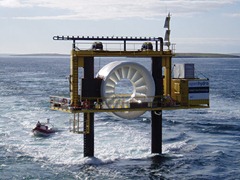A local company delivering innovation into marine renewables
 The recent publication of the Energy Bill shows the UK Government’s commitment to the development of low carbon energy sources. The Energy Bill will support the construction of a diverse mix of renewables including generation of wave and tidal energy. Closer to home, the announcement by Stormont in October 2012 of the allocation of 200MW wave and tidal energy development sites off the north coast of Antrim also built optimism for the future of the marine renewables sector in Northern Ireland.
The recent publication of the Energy Bill shows the UK Government’s commitment to the development of low carbon energy sources. The Energy Bill will support the construction of a diverse mix of renewables including generation of wave and tidal energy. Closer to home, the announcement by Stormont in October 2012 of the allocation of 200MW wave and tidal energy development sites off the north coast of Antrim also built optimism for the future of the marine renewables sector in Northern Ireland.
It may come as a surprise to readers that local company McLaughlin and Harvey are one of the world leaders in the offshore installation of wave and tidal energy turbines, having been active in this specialist field since 2005. The company is currently developing its own foundation and installation technique that has the potential to unlock many of the barriers to the full commercialisation of tidal energy, the world’s most predictable and consistent sustainable energy source.
The olive green McLaughlin and Harvey logo will be recognised by many readers, given that in recent years it has had pride of place on the construction landscape in Northern Ireland, having completed major local infrastructure projects. The company has constructed ferry terminals at both the Northern Irish and Scottish ends of Stena Line’s upgraded roll-on roll-off service between Belfast’s VT4 Terminal and Lough Ryan Port with a combined value of over £100 million. The firm has been successful in mitigating the worst effects of the recent downturn in the local civil engineering market by concentrating its civil engineering activities on the port and harbour sector which has remained somewhat buoyant and, despite an aggressive competitive marketplace, McLaughlin and Harvey have taken a significant share of marine construction activities in Scotland.
In parallel with these initiatives, McLaughlin and Harvey has also taken the decision to target the marine renewables sector by continuing to undertake installations for wave and tidal energy developments and are currently approaching the end of an initial research and development project.
 McLaughlin and Harvey entered the marine renewable market in 2006 when they were employed by Irish tidal energy development company OpenHydro to construct a piled test platform at the European Marine Energy Centre (EMEC) in Orkney, Scotland. Following this successful installation McLaughlin and Harvey carried out the subsea cabling works that resulted in OpenHydro’s turbine being the first tidal stream energy converter to be connected to and export power to the National Grid.
McLaughlin and Harvey entered the marine renewable market in 2006 when they were employed by Irish tidal energy development company OpenHydro to construct a piled test platform at the European Marine Energy Centre (EMEC) in Orkney, Scotland. Following this successful installation McLaughlin and Harvey carried out the subsea cabling works that resulted in OpenHydro’s turbine being the first tidal stream energy converter to be connected to and export power to the National Grid.
These projects were constructed using cutting edge methodologies; and were the first projects of this nature to be constructed in challenging tidal stream speeds of up to 10 knots.
Drawing on the experience gained during these operations, McLaughlin and Harvey devised and developed a method for the deployment of OpenHydro’s turbines on gravity base foundations. McLaughlin and Harvey was also closely involved with OpenHydro and RPS in the design, fabrication and commissioning of a vessel suitable for these installations. These gravity base structures weighing up to 1,000 tons are slung under the catamaran barge and are installed on the seabed in the fast flowing currents within 30 minutes. McLaughlin and Harvey carried out a trial deployment of a 6 metre diameter device at EMEC, Orkney, and installed a larger 10 metre diameter device in the Bay of Fundy, Nova Scotia, Canada.
McLaughlin and Harvey recently teamed up with Swedish firm Minesto AB to install a gravity base in Strangford Lough for its Deep Green Ocean Kite. The unique design of Minesto’s Sea Kite enables it to accelerate the speed of the water through its under-slung generator by up to ten times that of the tidal velocities. This feature increases the power output of the device as it flies through the tidal current and the device is ideally suited to the lower tidal speeds prevalent in the open sea.
McLaughlin and Harvey worked with local sub-contractors and suppliers to deliver the project ahead of the tight three week programme and on budget. This was a remarkable achievement, considering the necessary detailed design, fabrication and logistical issues and the fact that the deployment location is in an environmentally sensitive area.
McLaughlin and Harvey’s experience in these commercial deployments has led to further innovation by the company and it is currently developing a commercially viable foundation and installation system for the deployment of wave and tidal energy devices. The system is unique in that it does not require expensive offshore vessels; it is suitable for a range of seabed conditions and will accommodate the majority of the wave and tidal energy devices that are being developed at present. Invest Northern Ireland has helped fund the first phase of McLaughlin and Harvey’s research and development in this area.
Speaking at the 6th International Tidal Energy Summit in London, Marine Renewables Manager Adam Holland said: “This is a fledgling industry that has the potential to shape the future of renewable energy generation and we are committed to achieving that potential through our innovative foundation installation system which is capable of driving tidal energy to commercial viability. Our full scale prototype has been fabricated and is being tested at present and we aim to be ready for commercial scale deployments by 2014 when the first array developments are planned.”
 Adam Holland
Adam Holland
Marine Renewables Manager
McLaughlin & Harvey Ltd
Tel: 028 9034 2777
Mob: 07500 009246
Email: adam.holland@mclh.co.uk





